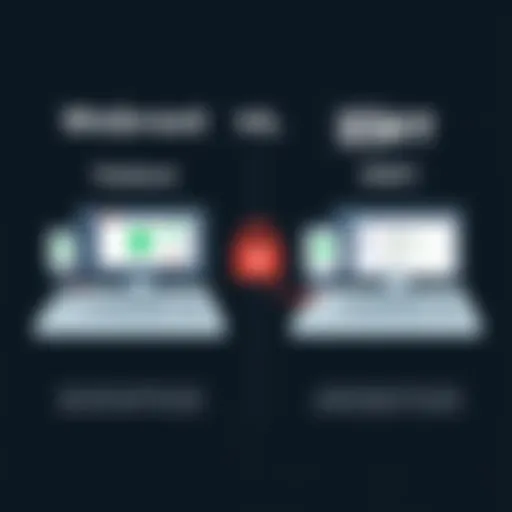Exploring Open Source 3D Design Tools and Techniques


Intro
Open source 3D design is not just a trend; it is an emerging field that is reshaping how we think about creativity and technology. The toolbox of open source software available for 3D design is both vast and varied. It opens up pathways for users, designers, and developers to innovate without being constrained by the limitations of traditional proprietary platforms. This article aims to highlight the importance of this transition, dissect the tools available, discuss the benefits and challenges, and explore the implications for different industries.
As tech-savvy individuals delve deeper into open source environments, understanding the landscape is crucial. This understanding not only allows for more informed decisions but also empowers users to harness the full potential of these resources.
The diversity of tools available in open source 3D design can be overwhelming. Each software package brings unique features, which can either complement or challenge existing workflows. In this context, it is also essential to understand current trends that impact software choice. The landscape continues to evolve as developers enhance features, improve user interfaces, and create robust communities for collaboration.
In the following sections, we will analyze the software options, assess their use cases, and provide insights into how they can be integrated into various workflows. The information presented will equip readers with a comprehensive foundation to navigate the intricate web of open source 3D design.
Open Source 3D Design: An Preface
Open source 3D design is a crucial topic in today's technological landscape. This area of design offers not just tools but also a philosophy aimed at accessibility, collaboration, and innovation. As industries become more reliant on 3D modeling and animation, understanding open source alternatives becomes essential for professionals at every level. The democratization of design tools through open source software has established a more level playing field. Individuals and organizations no longer need to invest heavily in proprietary software. Instead, they can leverage powerful tools that provide the same, if not superior, functionalities.
Definition and Overview
Open source 3D design refers to the creation and sharing of 3D modeling tools that are not restricted by proprietary licenses. This means that anyone can use, modify, and distribute the software according to their needs. The hallmark of open source software is transparency, allowing users to access the source code. This characteristic leads to the fostering of a vibrant community of developers and users who work collaboratively to improve features and fix bugs.
In practice, open source 3D design tools can be used in various applications, such as game development, architectural visualization, and product design. They often include features like modeling, rendering, and animating, similar to commercial software but without the associated costs. Many of these tools also offer extensive plug-ins and add-ons, enhancing their capabilities.
Historical Context
The roots of open source software trace back to the early days of computing. This philosophy gained momentum in the 1980s, as Richard Stallman advocated for free software as a means of ensuring users' freedom. The historically significant Linux operating system played a major role in illustrating the viability of this model. Over time, the concept expanded beyond operating systems to encompass a wide range of software, including 3D design applications.
With the advent of software such as Blender in the late 1990s, the open source 3D design landscape began to evolve significantly. Blender provided a comprehensive toolset for 3D modeling, animation, and rendering—all available without cost. This marked a shift where professional artists and hobbyists alike could enter the field without financial barriers. As technology has advanced, the number of open source 3D design solutions has continued to grow, catering to a broad array of users.
As more industries recognize the advantages of open source tools—like cost-effectiveness and flexibility—their adoption becomes more widespread. This ongoing evolution speaks to the importance of remaining engaged with current trends in open source 3D design.
The Significance of Open Source in 3D Design
Open source 3D design represents a paradigm shift in how creators and developers approach modeling, rendering, and animation. The significance of this movement lies in its potential to democratize access to powerful design tools while fostering innovation through collective knowledge and experience. In an era where proprietary software often imposes substantial financial barriers, open source solutions provide an alternative that emphasizes accessibility, community collaboration, and continuous advancement. This section explores these dimensions in detail, underlining why open source is invaluable in modern design practices.
Accessibility and Affordability
One of the cornerstone benefits of open source 3D design software is its accessibility. Users from various backgrounds, whether artists, engineers, or educators, find themselves capable of engaging with complex design technologies without the burden of expensive licenses. This broadens participation, allowing individuals from diverse socio-economic backgrounds to contribute their ideas to the design ecosystem.
Moreover, open source tools often provide matches for the functionalities of commercial software without imposing costs. For instance, programs like Blender and FreeCAD enable users to access high-end modeling capabilities without the prohibitive price tags associated with commercial alternatives. This opens doors for independent creators and small businesses that might not otherwise afford such tools. Additionally, the widespread availability of these tools encourages experimentation and creative exploration, which are vitally important in innovative fields.
Community Collaboration and Innovation
Community collaboration is another vital aspect of open source 3D design. The collaborative nature of open source platforms encourages contributors to share their modifications, bug fixes, and features with the community. This continuous development cycle results not only in improved software but also in the sharing of best practices and workflows among users. Communities centered around software such as Blender often organize events, forums, and workshops to facilitate knowledge transfer and skill enhancement.
The act of co-creating tools also drives innovation. Contributions from diverse perspectives lead to the rapid evolution of features tailored to users' needs. By collaborating in this way, open source platforms can respond to market demands more swiftly than proprietary systems, which may be constrained by corporate structures.
Collaboration can serve as a catalyst for unprecedented creativity. It brings together individuals with different ideas and skill sets, pushing the boundaries of what is possible in 3D design.
Popular Open Source 3D Design Software
Open source 3D design software has become a cornerstone for artists, engineers, and tech enthusiasts alike. With the ability to modify and distribute software freely, these tools break down many barriers associated with proprietary alternatives. They allow for a nimble approach to creativity, making 3D design more inclusive. Users can experiment without the hefty price tags of commercial tools. This segment highlights key software options that exemplify the open source philosophy.
Blender: A Comprehensive Tool
Features and Functionalities
Blender stands out for its extensive features that encompass everything from modeling to video editing. It offers a unified interface that is both powerful and flexible. A noteworthy characteristic is its support for a variety of workflows, including sculpting, rigging, and painting. Blender’s ability to integrate physics simulations sets it apart as a valuable choice for intricate design projects. However, the complexity may overwhelm beginners.
Use Cases
The versatility of Blender leads to a wide array of use cases. Artists leverage it for animations and visual effects, while engineers may use it for prototypes. Its range makes it a preferred option for various industries, creating high-quality results. Despite this, the software's extensive set of tools can sometimes result in a steep learning curve, requiring users to dedicate considerable time to mastering it.
User Community
Blender boasts a vibrant user community which greatly contributes to its development. Forums and social platforms are rich with tutorials, plugins, and user-generated content. This collaborative environment is beneficial for learning and troubleshooting. However, the quality of community support can vary, as not all contributors have the same level of expertise.
FreeCAD: Versatile Applications
Features Overview
FreeCAD is known for its parametric modeling capabilities. This allows users to easily make adjustments to designs without starting from scratch. It is particularly useful for engineering and architecture projects. A critical feature is its modular architecture, enabling users to customize functionality through plugins. Yet, its user interface can appear daunting to newcomers, which may hinder initial adoption.


Industry Applications
FreeCAD finds its niche in sectors like architecture and engineering. The software is designed with professional workflows in mind, making it an asset for serious projects. Its ability to export models in various formats enhances its interoperability with other software. However, the lack of a strong marketing strategy may limit its visibility in a crowded market.
User Demographics
The user base for FreeCAD spans students, hobbyists, and professionals. Students often use it for educational purposes, while engineers appreciate its depth. Its diverse demographic is a testament to its functional adaptability. However, potential users may overlook it due to its reputation as a complex tool.
OpenSCAD: Code-Based Modeling
Unique Selling Points
OpenSCAD distinguishes itself through its code-based modeling approach. This allows for precision and repeatability in designs that are often missing in graphical tools. Key characteristics include the ability to create complex geometries through algorithms. However, this method may alienate artists who prefer intuitive, visual design workflows.
Suitable Projects
This software is ideal for projects that require exact specifications, such as mechanical parts and architectural models. Its focus on design through coding makes it a popular choice among engineers and technical designers. On the downside, its niche application limits its broader appeal within the design community.
Learning Curve
OpenSCAD presents a significant learning curve, primarily due to its text-based approach. New users must become comfortable with programming concepts to effectively create models. While this may deter some, it ultimately fosters a deeper understanding of 3D design principles. Nonetheless, users seeking quick results might find it challenging to navigate.
Additional Options in Open Source 3D Design
In the expansive realm of open source 3D design, it is crucial to examine additional options that enhance the creative toolkit of designers. Beyond the well-known software like Blender and FreeCAD, alternatives such as SketchUp Free, Tinkercad, and Art of Illusion cater to diverse user needs and preferences. Understanding these tools provides users with greater flexibility and expression, essential for tackling various projects.
Open-source platforms empower users to experiment and customize their workflows. They also foster innovation through community contributions. Users can explore different functionalities and choose what best fits their design style. Recognizing these additional options is vital, as they may serve as a more accessible entry point for those new to 3D design or those with specific project requirements.
SketchUp Free: A Basic Tool
SketchUp Free is an entry-level offering that presents a straightforward user interface, ideal for beginners. Its web-based design allows users to start modeling without the overhead of installation. This availability makes it attractive to educational institutions and hobbyists who prefer quick access.
Key features of SketchUp Free include:
- Intuitive Navigation: Users find it easy to manipulate 3D models using simple tools like push-pull and orbit.
- Pre-Made Models: A vast library of components enables users to include standard objects without extensive modeling.
- Learning Resources: Official tutorials and community-generated content assist users in mastering the software.
While SketchUp Free offers excellent fundamentals, its functionality may be limited for complex projects. Nevertheless, it serves as a solid base for aspiring designers.
Tinkercad: User-Friendly Interface
Tinkercad, developed by Autodesk, is another accessible option in the open-source 3D design sphere. It targets users who may have little to no experience in 3D modeling. Its focus on simplicity is evident in its drag-and-drop interface, allowing for a low barrier to entry.
The tool comes with various benefits:
- 3D Printing Integration: Tinkercad supports straightforward file exports for 3D printing, making it a go-to choice for makers.
- Educational Focus: Widely used in classrooms, it promotes STEM learning through creative design activities.
- Rapid Prototyping: Users can quickly move from concept to a 3D model, facilitating fast iterations in designs.
Overall, Tinkercad stands out for its ease of use and educational applications, making it popular among novices.
Art of Illusion: Animation Focus
Art of Illusion presents a unique approach to 3D design by focusing more on animation capabilities. As an open-source software, it provides tools for model creation and animation, appealing to users with interests in dynamic visuals.
Benefits of using Art of Illusion include:
- Keyframe Animation: Users can create complex animations by manipulating keyframes, allowing for detailed control of movement.
- Scriptable Interface: The software supports scripting to automate tasks, catering to more technically inclined users.
- Community Support: With an active user community, resources and tutorials are available to help newcomers navigate the software’s features.
For animators and visual storytellers, Art of Illusion opens pathways to creating compelling narratives through 3D models.
Open-source tools enrich the 3D design landscape. They encourage creativity and exploration in ways proprietary software often does not.
Advantages of Open Source 3D Design Tools
Open source 3D design tools have reshaped the landscape of digital creation, allowing users to access powerful software without facing hefty financial burdens. This section outlines key advantages of these tools, especially for tech-savvy individuals and professionals seeking flexibility and innovation in their workflows.
Cost-Effectiveness
The primary attraction of open source 3D design tools is their cost-effectiveness. Traditional 3D design software often carries high licensing fees, making them inaccessible for many users. In contrast, open source programs like Blender and FreeCAD are free to use, allowing designers to allocate resources toward other areas of their projects. Additionally, even though these tools are free, they do not compromise on functionality. Users can find robust features comparable to expensive alternatives in open source software.
This cost-saving aspect encourages experimentation and skill development. Designers, students, and hobbyists can learn and practice without financial constraints. Such accessibility has democratized 3D design, leading to a growing pool of talent that can flourish in diverse sectors.
Customization and Flexibility


Another significant advantage of open source 3D design tools is their customization potential. Unlike proprietary software, which often locks users into specific workflows and features, open source programs provide an open framework for modifications. Developers can customize software to meet their specific needs.
For instance, experienced users can adapt Blender’s interface, add functionalities, or even create plugins. This level of flexibility invites innovative solutions and personalizes the design experience.
Moreover, users can build on existing projects or collaborate with others to enhance the tools. This characteristic fosters a dynamic ecosystem where continuous improvements are commonplace, further enriching user experience and product efficiency.
Extensive Support Networks
The community-driven nature of open source software is another distinct advantage. Users can benefit from extensive support networks, including forums, discussion groups, and documentation. For example, Blender has an active online community where users share tips, tutorials, and other resources.
In addition to community support, various platforms such as Stack Overflow and Reddit offer spaces for users to seek help and share knowledge. This wealth of resources makes navigating challenges more manageable, promoting peer-to-peer learning.
The collaborative spirit within the open source community often results in rapid development and iterative problem-solving, providing users with more effective and timely assistance.
In summary, the advantages of open source 3D design tools include cost-effectiveness, customization options, and strong support networks. These elements not only empower users but also contribute to a thriving ecosystem of creativity and innovation.
Challenges in Open Source 3D Design
Open source 3D design offers tremendous opportunities, yet it is not without challenges. Understanding these hurdles is crucial for anyone looking to effectively navigate this landscape. The significant challenges include steeper learning curves, integration with existing systems, and potential lack of support. Each of these elements requires attention for successful implementation of open source tools in projects.
Steeper Learning Curves
One of the most notable challenges with open source 3D design tools is the steeper learning curves. Unlike proprietary software with user-friendly interfaces and extensive tutorials, open source tools often assume a certain level of familiarity with technical concepts. For example, both Blender and FreeCAD have diverse functionalities, but new users may find it overwhelming to understand how to maximize their potential.
- Diverse Tools: With multiple tools available, mastering the basic features can take time and effort. Users often encounter many functions they might not be accustomed to in commercial software.
- Limited Documentation: While there is documentation, it may not be as comprehensive or structured as that provided by commercial software vendors. Users must often rely on user forums or community resources, which can vary in quality.
"While open source encourages experimentation, it can also lead to frustration for those not ready to engage deeply with the material."
The learning curve can deter some users from fully embracing open source options. It requires diligence and commitment, but overcoming this challenge can lead to substantial rewards in both skill development and creativity.
Integration with Existing Systems
Another obstacle is the integration of open source 3D design software into existing workflows and systems. Companies often have established ecosystems built around particular workflows, and the introduction of open source solutions may disrupt these.
- Compatibility Issues: Some open source tools may not seamlessly integrate with commonly used software, necessitating additional adjustments or software bridges. Users might have to invest time in finding compatible file formats or plugins.
- Adapting to Changes: Teams accustomed to proprietary solutions may face resistance when changing to open source software. Training and onboarding can be an added burden, particularly in larger organizations.
Thus, careful planning is essential to ensure that any new tools don’t simply add to the complexity of existing workflows but contribute positively to them instead.
Potential Lack of Support
Finally, a potential lack of support poses a significant issue. Unlike commercial products, which typically offer direct customer service, open source solutions depend on community forums and user engagement for support.
- Variable Quality of Support: There may be inconsistent levels of help available, as issues depend on community engagement and activity. Users may find faster resolutions for popular tools compared to those with smaller communities.
- Limited Professional Guidance: For critical projects, a lack of organized support can lead to risks. Organizations may hesitate to leverage open source software without guaranteed troubleshooting options.
Applications of Open Source 3D Design Across Industries
Open source 3D design tools provide vast opportunities across various sectors. Their importance lies not only in offering software alternatives but also in democratizing access to technology. Organizations and individuals can leverage these resources in innovative ways, enhancing productivity and creativity. The open-source model promotes collaboration and knowledge sharing, ensuring that communities can build and refine tools tailored to their specific needs.
Animation and Film
In the animation and film industry, open source 3D design software has become invaluable. Blender, for example, is used for creating stunning animated films and visual effects. This tool provides features such as modeling, texturing, shading, and rendering. Artists in independent studios benefit from the software's flexibility, as it does not come with licensing fees associated with proprietary software. This reduction in cost translates into more funds available for production quality and talent.
Moreover, community-generated resources enhance learning and creativity. Tutorials and forums, found on platforms like reddit.com, provide insights from experienced users, making it easier for newcomers to catch up. Collaboration occurs frequently in this domain, often leading to ground-breaking projects that rely on shared knowledge and materials.
Architecture and Engineering
The architecture and engineering fields utilize open source 3D design for various applications. Tools like FreeCAD allow professionals to create precise 3D models for buildings, mechanical components, or complex structures. This versatility is fundamental, as it facilitates design exploration and iterative development. Also, the open nature of these tools encourages customization, enabling firms to adapt them to specific workflow requirements.
In addition, FreeCAD supports parametric modeling, allowing adjustments to be made easily. This feature is crucial for architectural design, as changes are common through the development cycle. Furthermore, the cost-effectiveness of open-source solutions can lead to significant savings for projects, making resources available for other critical areas such as sustainability research or improving client interactions.
Gaming and Virtual Reality
Open source tools have significantly influenced gaming and virtual reality developments. Projects like Godot offer comprehensive game development features and flexibility. These tools provide developers with essential resources to create immersive environments without worrying about heavy licensing costs. Such advantages can lead to more experimentation and innovation within the gaming community.
With the rise of virtual reality experiences, open source design tools enable creators to explore user interactions seamlessly. Developers build diverse applications that cater to various user experiences, from educational platforms to art installations. The accessibility of these tools fosters a vibrant community, encouraging collaboration and shared resources that enhance the overall quality and variety of gaming experiences.
"Open source is a movement that empowers people and builds community. It's an ecosystem where everyone can contribute and benefit from collective knowledge."
In summary, open source 3D design plays a crucial role in animation, architecture, and gaming. These industries benefit from reduced costs, enhanced collaboration, and increased flexibility. As the technology continues to develop, the applications of open-source 3D design will likely expand, offering more innovative solutions and fostering creativity.
Best Practices for Using Open Source 3D Design Software


Using open source 3D design software comes with its own set of unique challenges and advantages. Adopting best practices can significantly enhance the user experience and the quality of the outcomes achieved. By focusing on defined workflows, utilizing community resources, and committing to continuous learning, users can efficiently leverage the power of open source tools.
Starting with a Defined Workflow
Establishing a well-defined workflow is essential for maximizing productivity in open source 3D design. Without a clear process, designers may find themselves overwhelmed by the myriad of available tools and features. A structured approach helps in organizing the design stages, from initial concepts to final output.
Key elements of a defined workflow include:
- Project Planning: Outline objectives and timelines. This ensures all team members stay aligned with project goals.
- File Management: Develop a system for organizing files efficiently. Classifying by type or version can save time later.
- Design Stages: Break down the design process into manageable phases like drafting, modeling, and rendering. This segmentation allows for focused efforts.
Implementing these practices helps avoid confusion and streamlines the overall process. A defined workflow facilitates better collaboration, especially in team environments.
Leveraging Community Resources
The open source community provides a rich repository of resources, all driven by the collaborative spirit inherent in these environments. Users can benefit significantly by tapping into these resources.
Community contributions can include:
- Tutorials and Documentation: Many projects maintain user guides and tutorials that help new users navigate complex software.
- Forums and Discussion Boards: Active platforms, such as Reddit or specific forums for programs like Blender and FreeCAD, offer chances to ask questions and solve issues collectively.
- Plugins and Extensions: Many contributors develop plugins that enhance functionality. These additions often stem from real user needs and can significantly improve workflows.
Regular engagement with the community fosters a sense of belonging and enhances learning. Moreover, the feedback and insights gained can be invaluable for improving skills.
Continuous Learning and Improvement
In the rapidly evolving field of technology, continuous learning is essential. This is especially true for open source 3D design, where tools, techniques, and community contributions frequently change. By committing to ongoing education, users can stay at the forefront of software developments.
Strategies for continuous learning include:
- Online Courses: Many platforms offer courses tailored to specific software, allowing for structured learning.
- Workshops and Meetups: Participating in local or online workshops enhances both practical skills and networking opportunities.
- Experimentation: Regularly testing new features or alternative software encourages adaptability and innovation.
Contributing skills to projects can also expose individuals to different aspects of design software, allowing for both personal and professional growth.
"In open source, the greatest asset is community knowledge. Regularly engaging and seeking improvement will ultimately enhance your design capabilities."
The Future of Open Source 3D Design
The future of open source 3D design holds significant promise as technology continues to evolve and integrate into various sectors. This domain is not just a passing trend; it is a fundamental shift in how design and creativity are approached. Open source 3D design tools allow for unparalleled access and customization, which is increasingly important in our tech-driven world. The benefits are clear: cost-effectiveness, community collaboration, and the endless adaptability of tools to suit specific needs. Understanding the upcoming trends and the growth of community involvement is essential for maximizing the potential of these resources.
Trends in Development
Several trends characterize the current landscape of open source 3D design. One notable trend is the increasing incorporation of artificial intelligence (AI) in design processes. AI can streamline workflows and enhance creativity, enabling users to generate complex designs with lower effort. Another trend is the move toward more robust cloud-based platforms. These platforms foster real-time collaboration, allowing designers from various locations to work together seamlessly.
Additionally, the availability of plugins and extensions for existing open source tools is growing. Users can customize their workflows further, adding features that cater to their unique requirements.
ul> li>strong>AI Integration:strong> Enhancing automation and design capabilities.li> li>strong>Cloud Solutions:strong> Facilitating remote collaboration and data sharing.li> li>strong>Expansion of Customization:strong> Broadening the scope of functionality for existing tools.li> ul>
These trends indicate that open source 3D design will likely become more user-centric, flexible, and capable of adapting to new demands.
Growing Community Involvement
The community aspect of open source 3D design cannot be understated. As more users engage with these tools, the collective knowledge and support network continue to expand. Platforms like Reddit and Facebook host vibrant groups where users share tips, tutorials, and iterative designs. This collaboration contributes significantly to the evolution of design practices.
Moreover, educational institutions are taking notice. Courses in open source 3D design are becoming more common, nurturing the next generation of designers who will contribute to this dynamic field. Users of all skill levels are encouraged to participate, fostering an inclusive environment where learning and sharing are prioritized.
"The growth of community involvement transforms traditional design spaces into collaborative ecosystems, enriching the learning experience for all involved."
Specifically, events like hackathons and design challenges are becoming regular occurrences, providing opportunities for real-world application and innovation. Participants can showcase their skills, learn from peers, and advance the state of open source development.
In summary, the future of open source 3D design is bright. With technological advances and increasing community collaboration, users can look forward to more powerful tools and a deeper connection to the broader design community.
Concluding Thoughts
In reviewing the expansive landscape of open source 3D design, it becomes clear that this segment of technology is not just a trend but a vital movement within the realm of digital design. The importance of engaging with open source tools lies in their ability to democratize access to powerful design capabilities. Users, regardless of their financial resources, can explore, create, and innovate without the burdens typical of commercial software licenses.
Reflection on Open Source Movement
The open source movement has significantly shifted paradigms in software development. This transition enables a broader range of users to participate actively in 3D design. With tools such as Blender and FreeCAD, the community-centric approach fosters collaboration and continual improvement. These programs exemplify how collective input and shared knowledge can yield projects that often rival proprietary offerings.
Furthermore, open source solutions encourage transparency, which enhances security and trust. When users can access source code and engage with it directly, they are empowered to understand the tools they use better. This engagement can lead to more tailored solutions for specific needs, ultimately pushing the boundaries of what can be achieved in 3D design.
Call to Action for Users
For those venturing into open source 3D design, the journey starts with engagement. Users are encouraged to:
- Experiment with various tools to find the right fit for their needs.
- Participate in community forums, offering insights and gaining knowledge.
- Share their work to inspire others and contribute to the growing body of online resources.
By taking these steps, users not only enhance their own skills but also promote the sustainability and growth of the open source ecosystem. This collective effort will ensure that open source 3D design continues to thrive and evolve, benefiting all who choose to join this inclusive and innovative field.







